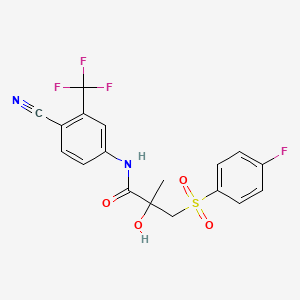Drug Information
Drug (ID: DG00705) and It's Reported Resistant Information
| Name |
Bicalutamide
|
||||
|---|---|---|---|---|---|
| Synonyms |
Bicalutamide; 90357-06-5; Casodex; Cosudex; Bicalutamide (CDX); Calutide; ICI 176334; ICI-176334; N-[4-cyano-3-(trifluoromethyl)phenyl]-3-(4-fluorophenyl)sulfonyl-2-hydroxy-2-methylpropanamide; N-(4-cyano-3-(trifluoromethyl)phenyl)-3-((4-fluorophenyl)sulfonyl)-2-hydroxy-2-methylpropanamide; Bicalutamide (Casodex); CHEMBL409; ICI 176,334; MFCD00869971; N-[4-Cyano-3-(trifluoromethyl)phenyl]-3-[(4-fluorophenyl)sulfonyl]-2-hydroxy-2-methylpropanamide; NSC-759816; Raffolutil; Kalumid; SMR000466329; Casodex (TN); SR-01000759410; BRN 5364666; Bicalutamine; Bicalutamide (JAN/USP/INN); Propanamide,; CCRIS 8728; HSDB 7655; Bicalutamide [USAN:USP:INN:BAN]; (+-)-4'-Cyano-alpha,alpha,alpha-trifluoro-3-((p-fluorophenyl)sulfonyl)-2-methyl-m-lactotoluidide; KS-1161; Bicalutamide - Casodex; CPD000466329; SCHEMBL3611; (R)-(-)-Bicalutamide-d4; MLS000759437; MLS001424047; Propanamide, N-(4-cyano-3-(trifluoromethyl)phenyl)-3-((4-fluorophenyl)sulfonyl)-2-hydroxy-2-methyl-, (+-)-; S-(+)-Bicalutamide-[d4]; GTPL2863; DTXSID2022678; BDBM18525; CHEBI:91617; AOB5596; EX-A962; CHEBI:144093; BCPP000337; HMS2051B13; HMS2089N12; HMS2232H03; HMS3263M13; HMS3372K05; HMS3393B13; HMS3654K18; HMS3714P13; Pharmakon1600-01504827; ACT06291; AMY33430; BCP02110; Tox21_501026; NSC722665; NSC759816; s1190; AKOS015895073; AC-4232; BCP9000408; CCG-100951; CCG-220876; CCG-222330; CS-1296; DB01128; LP01026; NC00201; NSC 759816; NSC-722665; SB17301; SDCCGSBI-0633779.P001; N-(4-cyano-3-(trifluoromethyl)phenyl); NCGC00167977-01; NCGC00167977-02; NCGC00167977-03; NCGC00167977-09; NCGC00167977-20; NCGC00261711-01; HY-14249; ICI176,334-1; Propanamide, N-[4-cyano-3-(trifluoromethyl)phenyl]-3-[(4-fluorophenyl)sulfonyl]-2-hydroxy-2-methyl-; DB-041165; B3206; FT-0618286; FT-0631069; FT-0663100; SW197581-4; Bicalutamide (CDX), >=98% (HPLC), powder; C08160; D00961; J10442; AB00639963-06; AB00639963-08; AB00639963-09; AB00639963_10; 357B065; A803039; A843528; Q1988832; SR-01000759410-4; SR-01000759410-5; BRD-A29485665-001-03-7; Bicalutamide, British Pharmacopoeia (BP) Reference Standard; Bicalutamide, European Pharmacopoeia (EP) Reference Standard; Bicalutamide, United States Pharmacopeia (USP) Reference Standard; 4'-cyano-3-[(4- fluorophenyl)sulfonyl]-2-hydroxy-2-methyl-3'-trifluoromethylpropionanilide; 4'-cyano-3-[(4-fluorophenyl)sulfonyl]-2-hydroxy-2-methyl-3'-trifluoromethylpropionanilide; Bicalutamide for system suitability, European Pharmacopoeia (EP) Reference Standard; Bicalutamide, Pharmaceutical Secondary Standard; Certified Reference Material; N-(4-cyano-3-(trifluoromethyl)phenyl)-3-((4-fluorophenyl)sulfonyl)-2-hydroxy-2-methyl-N-phenylpropanamide; N-(4-cyano-3-(trifluoromethyl)phenyl)-3-(4-fluorophenylsulfonyl)-2-hydroxy-2-methylpropanamide; N-[4-cyano-3-(trifluoromethyl)phenyl]-3-(4-fluorophenyl)sulfonyl-2-methyl-2-oxidanyl-propanamide; N-[4-cyano-3-(trifluoromethyl)phenyl]-3-[(4-fluorobenzene)sulfonyl]-2-hydroxy-2-methylpropanamide; N-[4-Cyano-3-(trifluoromethyl)phenyl]-3-[(4-fluorophenyl)sulfonyl]-2-hydroxy-2-methylpropionamide; N-[4-cyano-3-trifluoromethyl-phenyl]-3-[4-fluorophenyl-sulfonyl]-2-hydroxy-2-methyl-propionamide
Click to Show/Hide
|
||||
| Indication |
In total 1 Indication(s)
|
||||
| Structure |

|
||||
| Drug Resistance Disease(s) |
Disease(s) with Clinically Reported Resistance for This Drug
(1 diseases)
[1]
|
||||
| Target | Androgen receptor (AR) | ANDR_HUMAN | [1] | ||
| Click to Show/Hide the Molecular Information and External Link(s) of This Drug | |||||
| Formula |
C18H14F4N2O4S
|
||||
| IsoSMILES |
CC(CS(=O)(=O)C1=CC=C(C=C1)F)(C(=O)NC2=CC(=C(C=C2)C#N)C(F)(F)F)O
|
||||
| InChI |
1S/C18H14F4N2O4S/c1-17(26,10-29(27,28)14-6-3-12(19)4-7-14)16(25)24-13-5-2-11(9-23)15(8-13)18(20,21)22/h2-8,26H,10H2,1H3,(H,24,25)
|
||||
| InChIKey |
LKJPYSCBVHEWIU-UHFFFAOYSA-N
|
||||
| PubChem CID | |||||
| ChEBI ID | |||||
| TTD Drug ID | |||||
| VARIDT ID | |||||
| INTEDE ID | |||||
| DrugBank ID | |||||
Type(s) of Resistant Mechanism of This Drug
Drug Resistance Data Categorized by Their Corresponding Diseases
ICD-02: Benign/in-situ/malignant neoplasm
| Drug Resistance Data Categorized by Their Corresponding Mechanisms | ||||
|
|
||||
| Key Molecule: Androgen receptor (AR) | [2] | |||
| Molecule Alteration | Missense mutation | p.W742L (c.2225G>T) |
||
| Resistant Disease | Prostate cancer [ICD-11: 2C82.0] | |||
| Experimental Note | Identified from the Human Clinical Data | |||
| Key Molecule: Androgen receptor (AR) | [2] | |||
| Molecule Alteration | Missense mutation | p.W742C (c.2226G>T) |
||
| Resistant Disease | Prostate cancer [ICD-11: 2C82.0] | |||
| Experimental Note | Identified from the Human Clinical Data | |||
|
|
||||
| Key Molecule: Protocadherin beta-9 (PCDHB9) | [1] | |||
| Molecule Alteration | Expression | Up-regulation |
||
| Resistant Disease | Prostate cancer [ICD-11: 2C82.0] | |||
| Experimental Note | Identified from the Human Clinical Data | |||
| In Vitro Model | LN229 cells | Brain | Homo sapiens (Human) | CVCL_0393 |
| Experiment for Drug Resistance |
MTT assay | |||
| Mechanism Description | Bicalutamide has been widely used as a first-line treatment for PCa. Although patients initially show a favorable response to bicalutamide treatment, PCa eventually acquires bicalutamide resistance. Several factors have been shown to be involved in bicalutamide resistance. However, the mechanism of bicalutamide resistance is not fully understood. In this study, the knockdown of protocadherin B9 reduced nuclear AR translocation and bicalutamide resistance in androgen-dependent LNCaP cells in the presence of DHT. The overexpression of protocadherin B9 had no effect on bicalutamide resistance in androgen-independent DU145 cells. These results further indicate that protocadherin B9 is involved in bicalutamide resistance through the modulation of AR signaling. Taken together, our findings suggest that protocadherin B9 targeted therapy could be more effective therapy than bicalutamide alone for patients with PCa. | |||
References
If you find any error in data or bug in web service, please kindly report it to Dr. Sun and Dr. Zhang.
